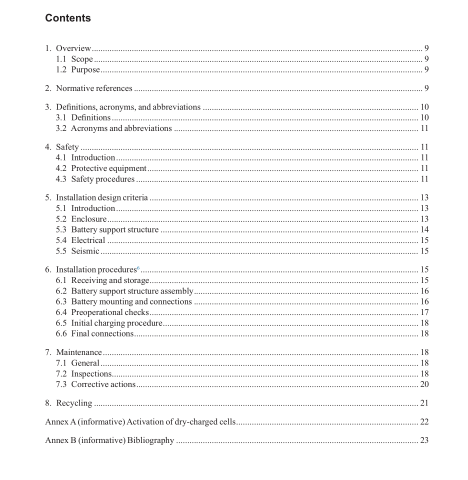IEEE 937-2019 pdf download.IEEE Recommended Practice for Installation and Maintenance of Lead-Acid Batteries for Photovoltaic (PV) Systems
4. Safety
4.1 Introduction The safety practices of the battery manufacturers and suppliers and those listed herein should be followed during battery installation and maintenance. Work performed on batteries shall be done with the proper tools and protective equipment. Battery installation shall be performed or supervised by personnel knowledgeable of batteries and the required safety precautions. Keep unauthorized personnel away from batteries.
4.2 Protective equipment In some cases, equipment requirements are different for vented lead-acid (VLA) batteries and valve-regulated lead-acid cell (VRLA) batteries. The following equipment is recommended for safer handling of lead-acid batteries and protection of personnel:
a) Full eye protection, such as goggles or a face shield (safety glasses for VRLA)
b) Protective clothing, including acid-resistant gloves, aprons, and overshoes (VLA only)
c) Portable or stationary safety shower and eyewash stations (both for VLA; eyewash only for VRLA)
d) A suitable acid-neutralizing agent, such as bicarbonate of soda (baking soda)
e) A lifting device of adequate capacity
f) Adequately insulated tools g) A Class C fre extinguisher (CO 2 -type extinguishers should not be used because of the potential thermal shock to batteries)
4.3 Safety procedures
4.3.1 Introduction The following are hazards inherent in the use of lead-acid batteries and the recommended related procedures to help ensure safety. In addition, NFPA 70E [B6] 4 identifes arc-fash hazards for dc voltages above 100 V. Most systems covered by this document have a nominal dc voltage of 48 V, for which no arc-fash protective equipment is required. A discussion of arc-fash hazards for dc voltages above 100 V is included in IEEE Std 484™ [B2].
4.3.2 Electrolyte hazards The electrolyte is a sulfuric-acid solution that is harmful to the skin, eyes, and internal organs. It is corrosive and electrically conductive. The following procedures should be followed when handling the battery and electrolyte:
a) Wear full eye protection and protective clothing.
b) If electrolyte contacts the skin, wash it off immediately with water.
c) If electrolyte contacts the eyes, immediately and thoroughly fush with water, then seek medical
attention.
d) If electrolyte is ingested, immediately drink water and contact poison control.
e) Spilled electrolyte should be neutralized. A common practice is to use a solution of approximately 500 g of bicarbonate of soda to approximately 4 L of water. The bicarbonate of soda solution should be added to the spilled electrolyte until the evidence of reaction (foaming) has ceased.
NOTE—The removal and/or neutralization of an acid spill may result in the production of a hazardous waste. The user should comply with the appropriate governmental regulations.
f) Properly dispose of unused electrolyte and electrolyte containers. These may be considered hazardous waste and should be treated accordingly.
4.3.3 Electrical hazards
A battery can present an electrical shock and short-circuit hazard. The following procedures should be
followed to lessen the risk of electrical hazards:
a) Remove watches, rings, or other metal objects.
b) Wear rubber or plastic gloves and boots.
c) Use tools with insulated handles.
d) Disconnect the charging source and load prior to opening or closing any other battery connections.
e) Determine if the battery is inadvertently grounded and, if so, remove source(s) of ground (e.g., electrolyte spillage). Contact with any electrically conductive path of a grounded battery can result in electrical shock; the likelihood of shock can be reduced if inadvertent grounds are removed.
4.3.4 Fire hazards
Lead-acid batteries can present a fre hazard because they generate hydrogen gas (see 5.2.4) and are capable of producing high current. The following procedures should be followed to lessen the risk of fre hazards:
a) Provide ventilation in accordance with item a) of 5.2.4.
b) Prohibit smoking in the battery area.
c) Keep the battery area free from open fames and arcs.
d) Discharge static electricity from body before touching batteries by frst touching a grounded metal surface, such as a water pipe.
e) Use fame-arresting vents, if the cell design allows.
f) Maintain battery and connections in accordance with Clause 7.
g) Follow proper installation procedures (see Clause 6).
h) Use of any auxiliary devices, such as hydrogen recombiners or fame arresters, should be in strict accordance with the battery manufacturer’s recommendations.IEEE 937 pdf download.IEEE 937-2019 pdf download
IEEE 937-2019 pdf download

Leave a Reply